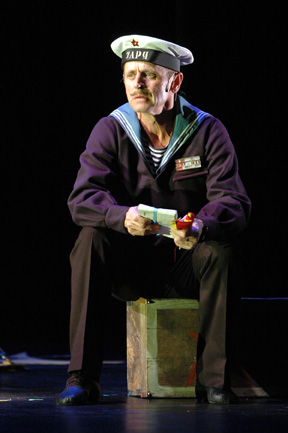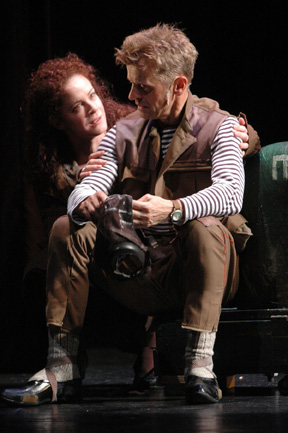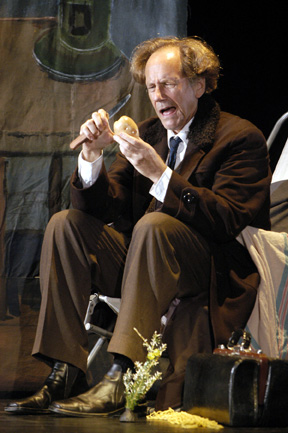Letter from New York
Forbidden Christmas, Or The Doctor and the Patient
 The
theater offerings at the Lincoln Center Festival sometimes include dancing
or movement that verges on dancing. An enchanting example is “Forbidden
Christmas,” written, directed, and designed by the theater director
of Russian Georgia Rezo Gabriadze and starring Mikhail Baryshnikov as
a young sailor, driven mad by rejection in love, who fantasizes that,
at will, he can turn his legs into a car, which his upper body steers
in order to get him someplace real. As it turns out, the driver portion
of him doesn’t have the best of navigating skills, but the car never
breaks down, even in what seems to have been the worst snowstorm in Kutaisi,
in Soviet Georgia, during Christmas Eve of 1952, the setting of the show.
That night, the car-man, named Chito, who lives with his babushka mother
(Yvonne Woods) consults the town doctor (an adorably exasperated Jon DeVries)
with the urgent plea for the doctor to “drive” with him to
attend to a little girl who has swallowed iodine. Despite getting lost
and separated—and an interlude in which Chito receives a vision
of God, by way of the power lines of two electrical towers (I didn’t
quite understand this scene at the time, but a colleague explained it
to me later)—he does finally rediscover the doctor, who is wandering
around in snowdrifts, thinking about the wife whom he. . .betrayed? lost
to disease? (No one explained this part.) The two men, reunited, run up
about a 1,000 imaginary stairs of a Stalinist apartment house to a flat
in which, indeed, there is a distraught mother and an (invisible) child,
who turns out to be all right after having tasted iodine. And it also
turns out that they are Chito’s wife—the very young woman
(Pilar Witherspoon), in fact, who had earlier rejected him for a richer
suitor—and child. At one point earlier in the story, the doctor
gets fed up with Chito, beats him up, and tells him he’s a nutcase.
This “cures” Chito by shoving him headfirst into the reality
of the Soviet Union in 1952, a place where the entire society is, metaphorically
speaking, pretending that it has the wheels and fuel to get somewhere
real. Given the circumstances then of that country—in which, if
“Forbidden Christmas” can be relied on as a guide, fantasy,
artistic and personal, was so repressed that it exploded as insanity,
and in which any formal tradition of hope, such as Christmas, was forbidden
to observe (the doctor celebrates it secretly with a withered miniature
tree, clearly an unornamented veteran of many forbidden Christmases and
easily hidden from spies)==to force Chito to recognize the truth of his
miserable existence is, the doctor realizes, a very cruel thing to do.
I think the story ends happily, with Chito having retrieved his car from
the junkshop of reality, his wife loving him unconditionally, their child
okay, and the doctor finally able to go back home and sit down long enough
to pass out.
The
theater offerings at the Lincoln Center Festival sometimes include dancing
or movement that verges on dancing. An enchanting example is “Forbidden
Christmas,” written, directed, and designed by the theater director
of Russian Georgia Rezo Gabriadze and starring Mikhail Baryshnikov as
a young sailor, driven mad by rejection in love, who fantasizes that,
at will, he can turn his legs into a car, which his upper body steers
in order to get him someplace real. As it turns out, the driver portion
of him doesn’t have the best of navigating skills, but the car never
breaks down, even in what seems to have been the worst snowstorm in Kutaisi,
in Soviet Georgia, during Christmas Eve of 1952, the setting of the show.
That night, the car-man, named Chito, who lives with his babushka mother
(Yvonne Woods) consults the town doctor (an adorably exasperated Jon DeVries)
with the urgent plea for the doctor to “drive” with him to
attend to a little girl who has swallowed iodine. Despite getting lost
and separated—and an interlude in which Chito receives a vision
of God, by way of the power lines of two electrical towers (I didn’t
quite understand this scene at the time, but a colleague explained it
to me later)—he does finally rediscover the doctor, who is wandering
around in snowdrifts, thinking about the wife whom he. . .betrayed? lost
to disease? (No one explained this part.) The two men, reunited, run up
about a 1,000 imaginary stairs of a Stalinist apartment house to a flat
in which, indeed, there is a distraught mother and an (invisible) child,
who turns out to be all right after having tasted iodine. And it also
turns out that they are Chito’s wife—the very young woman
(Pilar Witherspoon), in fact, who had earlier rejected him for a richer
suitor—and child. At one point earlier in the story, the doctor
gets fed up with Chito, beats him up, and tells him he’s a nutcase.
This “cures” Chito by shoving him headfirst into the reality
of the Soviet Union in 1952, a place where the entire society is, metaphorically
speaking, pretending that it has the wheels and fuel to get somewhere
real. Given the circumstances then of that country—in which, if
“Forbidden Christmas” can be relied on as a guide, fantasy,
artistic and personal, was so repressed that it exploded as insanity,
and in which any formal tradition of hope, such as Christmas, was forbidden
to observe (the doctor celebrates it secretly with a withered miniature
tree, clearly an unornamented veteran of many forbidden Christmases and
easily hidden from spies)==to force Chito to recognize the truth of his
miserable existence is, the doctor realizes, a very cruel thing to do.
I think the story ends happily, with Chito having retrieved his car from
the junkshop of reality, his wife loving him unconditionally, their child
okay, and the doctor finally able to go back home and sit down long enough
to pass out.
 From
time to time, Chito’s guardian angel (choreographer Luis Perez),
wearing street clothes, devilishly red spats, and one or two wings, two-steps
through the action, dragging references behind him to a lot of movies
(all, naturally, invisible). When Yvonne Woods isn’t looking ridiculous
in her attempt to add 60 years to herself as Chito’s mother, she
makes a very nice snowstorm, thanks to a headdress of snowballs (visible)
and our (invisible) memories of the headdress’s allusion to the
Snowflakes’ headdresses in the first, 1892 Maryinsky production
of “The Nutcracker.”
From
time to time, Chito’s guardian angel (choreographer Luis Perez),
wearing street clothes, devilishly red spats, and one or two wings, two-steps
through the action, dragging references behind him to a lot of movies
(all, naturally, invisible). When Yvonne Woods isn’t looking ridiculous
in her attempt to add 60 years to herself as Chito’s mother, she
makes a very nice snowstorm, thanks to a headdress of snowballs (visible)
and our (invisible) memories of the headdress’s allusion to the
Snowflakes’ headdresses in the first, 1892 Maryinsky production
of “The Nutcracker.”
According to a program essay and a note, the action of “Forbidden Christmas” was devised by Gabriadze in collaboration with his all-American cast, which, after some toing and froing about union hours for rehearsal, put the show together in New York. It exists because Baryshnikov saw Gabriadze’s production at the 2002 Lincoln Center festival of “The Battle of Stalingrad” and wanted to work with the Georgian. In the manner of Martha Clarke’s often mute theatrical stagings, of some Bread-and-Puppet Theater productions, and of much downtown, image-based theater these days, the hour and ten-minute show, which was presented in the 611-seat John Jay Theater, is a kind of vaudeville of the performing arts, containing mime, naturalistic physical acting, some word-based acting (mostly on the part of the doctor, perhaps because Jon DeVries is the only member of the cast who really has control of his voice), glimpses of dancing (usually satirical), expert puppetry, and stage direction emphasizing the idea that what you can see (of a person, a set, a prop) only stands in for a larger, invisible whole. This mélange of theatrical elements is familiar from much Eastern European theater, too; yet I’ve never seen it carried through with quite as much charm as here. Even though I was frequently puzzled by the words, I loved the theater of this show. The town in a blizzard is created by two whirling panels, fetchingly painted (by Gabriadze, who is also a sculptor and a book illustrator) on each side with a different scene of a town in a snowstorm. The sea in which the rejected Chito almost drowns himself is created by a brilliantly evocative arrangement of long, crooked, horizontally arranged wooden poles, positioned at different heights from the floor and turned on spits by several of the actors, to give a sense of waves churning. The doctor has an anxiety dream that is presented as a “movie” (large, black-and-white paintings of “stills” that are turned). It all looks childlike, untutored, home-made, and lighting designer Jennifer Tipton, the (invisible) ballerina of the show, has unpacked her full array of effects, creating sunsets and sunrises, power stations in snow-bound mountains, the moon and the Milky Way, and, perhaps most beautiful, warmth and illumination in the midst of Chito’s otherwise unbearable apartment.
 Meanwhile,
to plaintive folksongs sung, I think, in Georgian, Baryshnikov is resurrecting
Charlie Chaplin and Buster Keaton. His great virtuoso turn is starting
his “car,” which is realized as a jellylike trembling through
his body as he turns a window crank against his chest and the “engine”
turns over. Of all the physical comedy and virtuosity, though, the greatest
moment, for me, happened early on, when Chito is still sane. He alights
from his “ship” (a miniature model of a ship), negotiates
the wooden “waves,” and arrives on land to find his fiancée
on the point of running off with a mustachioed rival. She hands Chito
back his letters to her and takes off a necklace to hand that back, too.
He sits down on his suitcase, still holding them, and we see him begin
to fall apart from the inside out. His head remains still, his expression
has frozen, but his eyes seem to contract and to moisten from (invisible)
sources. Over a period of several minutes, his face reddens, and his vision
melts into tears that never fall. For all of its fantasy, the heart of
“Forbidden Christmas” is located in these astoundingly super-real
effects. (The doctor’s attempt to relax in his office chair is another.)
It doesn’t much matter what they mean to the story: their recreation
of recognizable details and miniscule transitions from life is physical
theater at its most refined—meaning enough.
Meanwhile,
to plaintive folksongs sung, I think, in Georgian, Baryshnikov is resurrecting
Charlie Chaplin and Buster Keaton. His great virtuoso turn is starting
his “car,” which is realized as a jellylike trembling through
his body as he turns a window crank against his chest and the “engine”
turns over. Of all the physical comedy and virtuosity, though, the greatest
moment, for me, happened early on, when Chito is still sane. He alights
from his “ship” (a miniature model of a ship), negotiates
the wooden “waves,” and arrives on land to find his fiancée
on the point of running off with a mustachioed rival. She hands Chito
back his letters to her and takes off a necklace to hand that back, too.
He sits down on his suitcase, still holding them, and we see him begin
to fall apart from the inside out. His head remains still, his expression
has frozen, but his eyes seem to contract and to moisten from (invisible)
sources. Over a period of several minutes, his face reddens, and his vision
melts into tears that never fall. For all of its fantasy, the heart of
“Forbidden Christmas” is located in these astoundingly super-real
effects. (The doctor’s attempt to relax in his office chair is another.)
It doesn’t much matter what they mean to the story: their recreation
of recognizable details and miniscule transitions from life is physical
theater at its most refined—meaning enough.
–Mindy Aloff
Photos, all by Stephanie
Berger:
First, Mikhail Baryshnikov.
Second, Pilar Witherspoon with Mikhail Baryshnikov.
Third, John DeVries.
Originally
published:
www.danceviewtimes.com
Volume 2, Number 27
July 19, 2004
Copyright © 2004 by Mndy Aloff
|
|
|